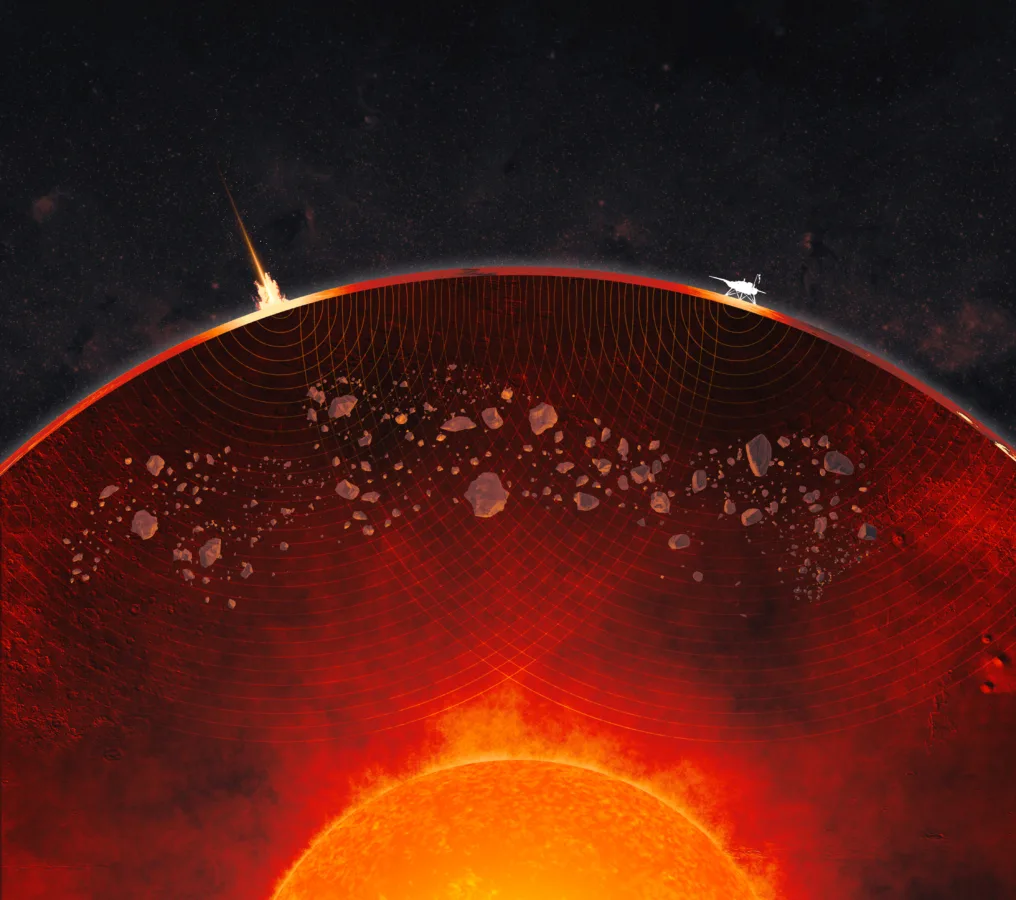Scientists have long been fascinated by Mars’ mysterious internal structure and what it can reveal about the planet’s turbulent past. Now, using data from the largest marsquake ever recorded, a team of researchersfrom UCLA’s Department of Earth, Planetary, and Space Sciences (EPSS) has uncovered new evidence that the Martian crust is layered and more complex than previously understood. The work was recently published in Physics of the Earth and Planetary Interiors.
The marsquake, which registered a magnitude 4.7, was detected during the final phase of NASA’s InSight mission. Unlike previous events, this seismic tremor generated two different types of surface waves and their more complex form, called higher mode surface waves, making it the only tectonic event on Mars to produce such a dataset. These waves travel along the surface of a planet, and by comparing the vertical and horizontal motion of the ground, researchers can infer detailed structural information.
Caroline Beghein, a geophysics professor at UCLA and a participating scientist on the InSight mission, led the analysis of this rare seismic data. Her work revealed that seismic waves travel faster horizontally than vertically through the Martian crust — a phenomenon known as seismic anisotropy. This effect, stronger in the lower crust than the upper layers, points to a stratified structure formed by distinct geological events.
“This work continues a deep tradition of excellence in planetary seismology and magnetometer development at UCLA EPSS and builds on our years of collaboration with important government institutions like NASA.” – Caroline Beghein
“This directional pattern tells us that Mars’ crust wasn’t formed in one go,” said Beghein. “Instead, it likely developed in stages and was potentially shaped by ancient volcanic eruptions or massive asteroid impacts. These processes created layers that influence how seismic energy travels through the planet.”
This finding sheds new light on one of Mars’ oldest mysteries: the striking difference between the heavily cratered southern highlands and the smoother, lower northern plains. One leading theory posits that a massive impact reshaped the northern hemisphere early in Mars’ history, followed by widespread volcanic activity. The seismic anisotropy detected in this study may be a direct result of those transformative events.
While the mission officially ended after four years due to dust covering the lander’s solar panels, its legacy continues through the wealth of data it produced. “The InSight mission was a major international collaboration, with leadership from NASA’s Jet Propulsion Laboratory (JPL), along with institutions in Switzerland, France, and Germany.
UCLA’s role in the larger mission was instrumental. Beyond Beghein’s seismic analysis, UCLA scientists were also responsible for providing the onboard magnetometer, one of the mission’s key instruments and an area in which UCLA EPSS is a world-leader. “This work continues a deep tradition of excellence in planetary seismology and magnetometer development at UCLA EPSS and builds on our years of collaboration with important government institutions like NASA,” said Beghein.
Understanding how the Martian crust formed offers a window into how rocky planets, including Earth, evolve over time. Each new insight from Mars brings us one step closer to unraveling the complex history of planetary formation across the solar system.
 A cutaway view of Mars in this artist’s concept (not to scale) reveals debris from ancient impacts scattered through the planet’s mantle. On the surface at left, a meteoroid impact sends seismic signals through the interior; at right is NASA’s InSight lander.
NASA/JPL-Caltech
A cutaway view of Mars in this artist’s concept (not to scale) reveals debris from ancient impacts scattered through the planet’s mantle. On the surface at left, a meteoroid impact sends seismic signals through the interior; at right is NASA’s InSight lander.
NASA/JPL-Caltech